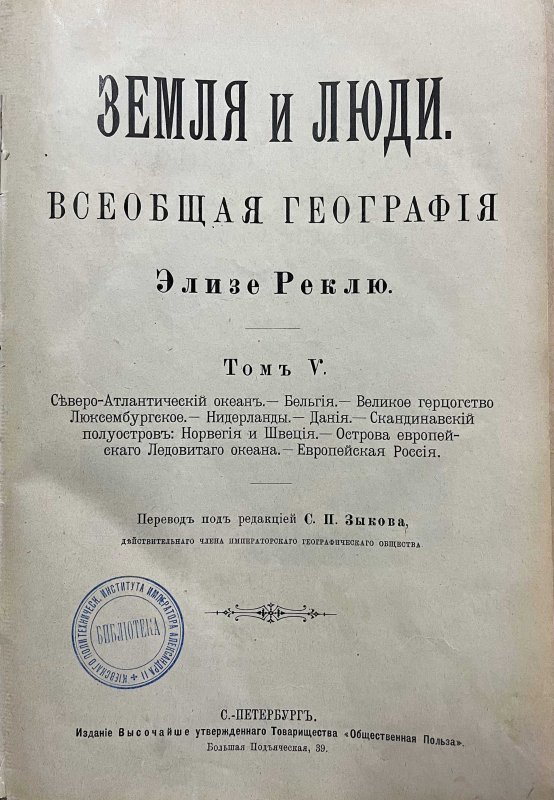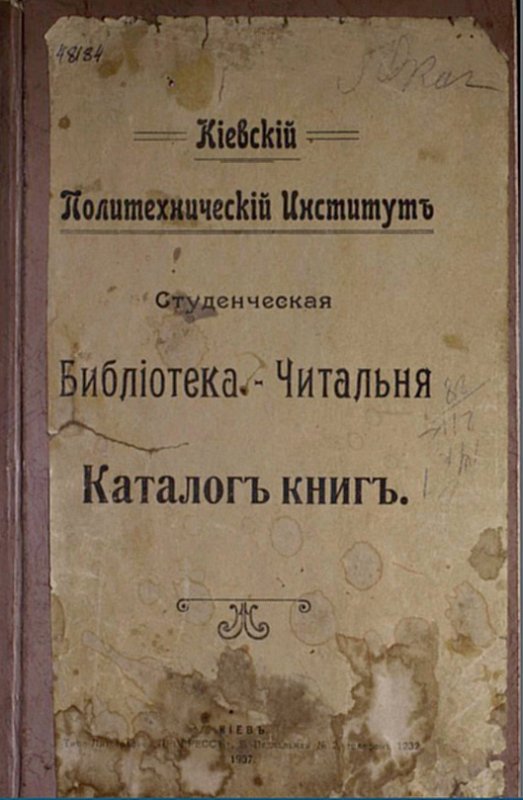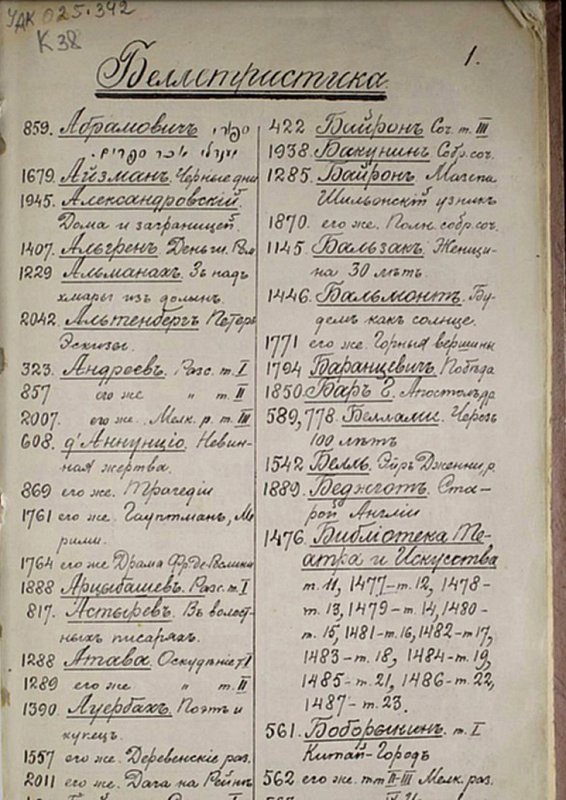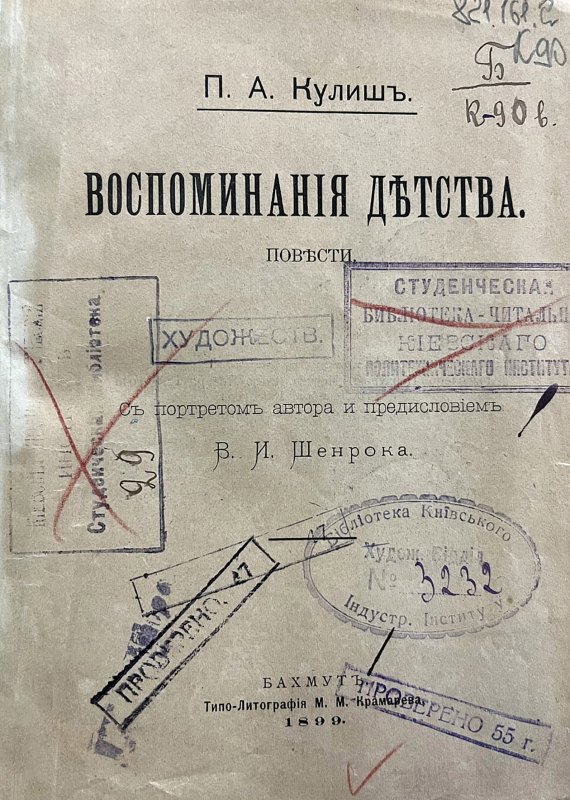The collection of rare and valuable editions of the Scientific and Technical Library contains a lithographed edition of 1907 "Kyiv Polytechnic Institute. Student Library-Reading Room. Catalog of Books" printed by the Kyiv printing house "Progress". "The catalog is 39 pages long and contains the following sections: "Fiction"; "Social and legal sciences"; "Philosophy, psychology, ethics, logic and aesthetics"; "Publicistics, criticism and biographies"; "Natural sciences and astronomy"; "Reference books". The publications are arranged in alphabetical sections, and each title has a number, possibly an inventory number.

Library staff occasionally find books in the general collection with the stamp of the reading library: a rectangular purple frame with the text inside: "STUDENT || READING LIBRARY || KIEV || POLYTHECHNICAL INSTITUTE".
Little information about the reading room has been preserved. Here are a few references to it in connection with the revolutionary events of 1902: "...During the strike, students gathered at the Institute, read newspapers and revolutionary publications, which were plentiful. In this regard, the Library-Reading Room, run by Mr. Vladimirov, was of great service to the students..." In a police report of March 15, 1902, we read: "In recent times, in the reading room of the Polytechnic Institute, there have been openly placed on the tables advertisements for the sale of various illegal publications in favor of injured students and patrons, and not only student bulletins but also revolutionary publications, including Iskra ("Kyiv Polytechnic and Kyiv Agricultural Institutes of the XXV Century. 1898 - 1923, Jubilee collection", p. XV, spelling in the original).
In later years, the library-reading room was the center of the revolutionary students of the Kyiv Polytechnic Institute: "For 3-4 years [1912-1915], the general student library-reading room was the center around which all organized students united. It was a kind of parliament... the fact that the revolutionary students valued the library-reading room is evidenced by the fact that they unanimously decided not to post or even bring proclamations into the reading room, so as not to provoke reprisals..." (Ibid., p. XXXI, spelling in the original).
Thus, from the above it becomes clear the role of the Reading Room in the political and social life of students. In this sense, the repertoire of publications that made up its collection is very revealing.
A significant part of the literature is economics, political economy, and historical sketches of the economic development of European countries. The authors include well-known names of economists, university professors, or political figures, mostly German, English, French, and Russian. There are also works by the prominent Ukrainian economist M. Tugan-Baranovsky: "Essays on Modern Political Economy," "The Russian Factory," and "Industrial Crises."
Several publications are devoted to Ukrainian history:
- "History of Little Russia: from the creation of the Slavs to the destruction of the Hetmanate" (1822) by Ukrainian historian Dmytro Mykolaiovych Bantysh-Kamenskyi. The library presents a reprint of the 1993 book in the series "Ukraine. Voices of History" series;
- "Modern Galicia" by Polish publicist and ethnographer Leon Wasilewski (1900);
- "Sketches of the History of the Ukrainian People" by Mykhailo Hrushevsky (1904, the library has a reprint of 1991).
The catalog also includes works by the prominent Ukrainian historian Dmytro Yavornytsky: "Freedoms of Zaporizhzhia Cossacks," "In the Footsteps of the Cossacks," "Ivan Dmytrovych Sirko," and two volumes of "History of Zaporizhzhia Cossacks" of 1892 (often the printed works bear the surname Evarnytskyi, as it is in the catalog); the library also has several modern reprints of the latter work. All books are published in Russian.

The section of fiction, i.e. popular fiction, is the largest in the catalog. What did the Polytechnic students read? Mostly works of world classics, books by Russian and Ukrainian writers. Many names have long been forgotten, but were popular in the late nineteenth and early twentieth centuries.
Among the Ukrainian authors are Taras Shevchenko, Ivan Franko, Ivan Tobilevych (Karpenko-Kary), Panas Myrnyi, Levytskyi (Nechuy-Levytskyi), Mykhailo Kotsiubynskyi, and others. Some of these books have been preserved in the library, most of them were published during his lifetime. For example, two books by Ivan Franko: a collection of poems "From the Heights and the Lowlands" (1893, second revised edition; published by the Shevchenko Scientific Society in Lviv at the expense of Olha Franko, Ivan Yakovych's wife. The second edition is characterized by significant differences from the first, which makes the book a significant literary and bibliographic monument) and the story "Cross Paths" (1899, also published in the printing house of the Shevchenko Scientific Society, but at the expense of the editorial board of the Literary and Scientific Bulletin). Or Panteleimon Kulish's Memoirs of Childhood (published in Bakhmut in 1899), three stories in which Kulish proved himself a bright master of the autobiographical novel.

All of these books bear the stamp of the Student Library-Reading Room.
The list of fiction also includes two books by Camille Flammarion (1842-1925), a popular astronomer, researcher, and author of numerous popular science works. He also wrote fiction. These are the ones recorded in the catalog of the Reading Library: "In the Heavens" and "The End of the World". Another of his publications, Popular Astronomy (1880), is listed in the section "Natural Sciences. Astronomy" section and is still kept in the collection of rare and valuable editions of our library.
The section on natural sciences includes many interesting scientific and popular science publications. One of them is also preserved in the library. These are the nineteen volumes of the French geographer Elise Reclus' Earth and People (1873-1893), which presents all regions of the planet Earth with a description of the territory, climate, natural features, and peoples inhabiting them. Interestingly, Volume 5 separately describes the Ukrainian lands as an independent geographical unit. The text extensively quotes Ukrainian historians, including Mykhailo Drahomanov, with whom the author had friendly relations.

The History of Arts by the French historian and archaeologist Charles Bayeux (1849-1918), published by Stefan Kulzhenko's Kyiv publishing company in 1902, is very valuable. The author consistently presents the history of architecture, painting, and sculpture, clearly demonstrating the inextricable links between all types of fine art. The textual material is successfully combined with illustrative material: the book contains many drawings and photographs. This is a Russian translation of the 1886 edition, edited and supplemented by Professor Hryhorii Hryhorovych Pavlutskyi of St. Volodymyr's University in Kyiv (Hryhorii Hryhorovych Pavlutskyi (1861-1924) was a Ukrainian art historian, researcher of ancient Ukrainian architecture and iconography, one of the well-known representatives of Ukrainian art history, Doctor of Theory and History of Arts, Professor at Kyiv University).

In addition to the stamp of the library-reading room, one of the editions bears the stamp of the Artistic Circle of Polytechnic Institute students with the date of November 15, 1903. The book is a collection of theatrical feuilletons.
A significant part of the collection consisted of biographies of prominent people - writers, scientists, and philosophers. The catalog contains the names of Newton, Pascal, Leibniz, and Taras Shevchenko.
A small section of reference books was filled with various catalogs, reference books, and dictionaries. There were also KPI News, reports on KPI activities, and a list of KPI students for 1902-1903.
Thus, a small list of publications used by future engineers can tell a lot to interested researchers of the history of our university. The electronic version of the book is presented in the Digital Library of Kyiv Polytechnic, it is available to everyone at https://dil.kpi.ua/

